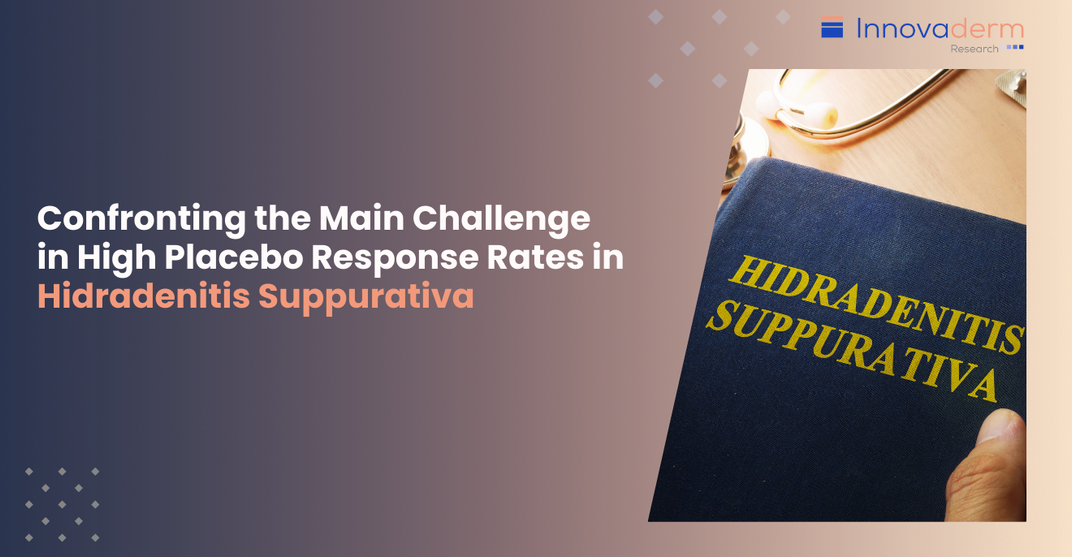Confronting the Main Challenge in High Placebo Response Rates in Hidradenitis Suppurativa

Table of contents:
When addressing the biggest hurdle in drug development for Hidradenitis Suppurativa (HS), the issue of high placebo response rates in clinical trials is unmistakably significant. The challenge lies in distinguishing between the mechanism of action (MOA) from placebo response at the endpoint. It is crucial to recognize that the primary concern often stems from the variability in rater assessments (inconsistent agreement among raters), rather than the efficacy of the placebo or any deficiencies in the performance of the MOA. The high rate of placebo response is not a testament to the placebo’s effectiveness, but rather an indication of the variability in the assessment made by different raters. As we gain experience from numerous phase 2 and phase 3 trials in the world of HS, some consistent patterns have come to light. In numerous instances, the MOA demonstrates a strong performance at achieving high response rates. While we certainly aim for further improvements, it is fair to state that it currently holds a commendable position. However, placebo response rates occasionally come strikingly close, a phenomenon that has raised some valid concerns. In fact, approximately 45–55% of patients achieved the Hidradenitis Suppurativa Clinical Response (HiSCR) endpoint with the MOA in phase 2 and 3 studies compared to roughly 35–50% with the placebo.
1. The Role of the Disease

First things first, we need to debunk the idea that HS’s unpredictable nature is solely to blame for our predicament. It is well known that HS has its fluctuations, a reality readily acknowledged by patients. In Dr. Garg’s everyday practice, observing about 35% of HS patients experiencing a substantial 50% improvement within a 12-week period without any treatment is uncommon; therefore, it would be unlikely that treatment with a placebo control be more effective at improving HS severity compared to the standard of care. If that was the case, all patients would be considering participation in HS clinical trials. Consequently, it seems improbable that the disease alone is responsible for these notable outcomes.
2. The Role of the Measurement Metric

In today’s HS clinical trials, the HiSCR metric stands as the primary outcome measure. On a theoretical level, HiSCR seems like a reasonable choice, encompassing 2 prevalent and crucial HS lesions: abscesses and nodules, which hold significant relevance for patients. Nonetheless, criticism has arisen regarding its strict criteria, whereby even a minimal increase in 1 abscess or fistula designates a patient as a non-responder. While the rigor might prompt some debate, the tool itself remains a valid and meaningful clinical endpoint for assessing the effectiveness of MOA under development.
3. The Role of the Raters

Lastly, the human factor should not be overlooked when investigating the challenges encountered in HS clinical trials. It is possible, even probable, that the assessors contribute to the discrepancies seen in our data. Therefore, the question arises: What factors related to the assessors might be causing these differences?
In conclusion, the primary obstacle in HS lies in the perplexing issue of high placebo response rates in clinical trials and the inadequate differentiation between the MOA and placebo effects. This challenge cannot be solely attributed to the natural variability of the disease or the measurement metric. Rather, the human factor appears to contribute to the observed data variability. Addressing this multifaceted challenge requires future research and clinical trials to meticulously analyze the role of assessors while maintaining a rigorous measurement approach and a comprehensive understanding of the unique nature of HS.
About the Author
Dr. Amit Garg is a professor and founding chairman of the Department of Dermatology at the Zucker School of Medicine at Hofstra University. He is also a professor in the Center of Health Innovation and Outcomes Research at the Feinstein Institutes for Medical Research. Dr. Garg was awarded the 2016 Thomas G. Pearson Educational Memorial Education Award by the American Academy of Dermatology.
Let’s shape the future of research and make a difference in the industry, gain Innovaderm’s support in your upcoming trial and propel your study to new heights.
Newsletter
Newsletter subscription resources

